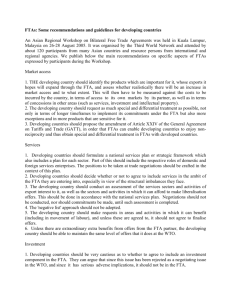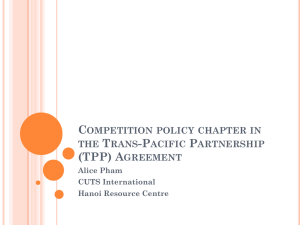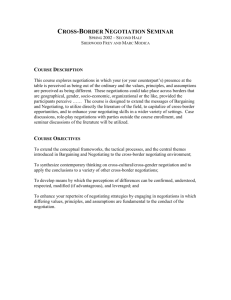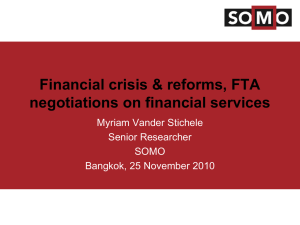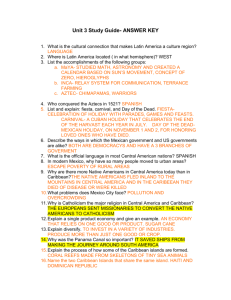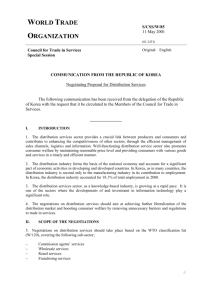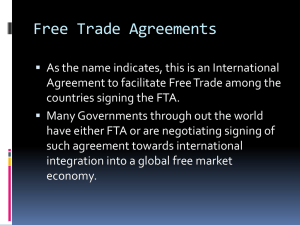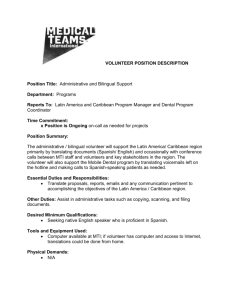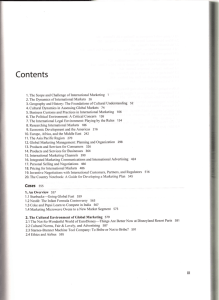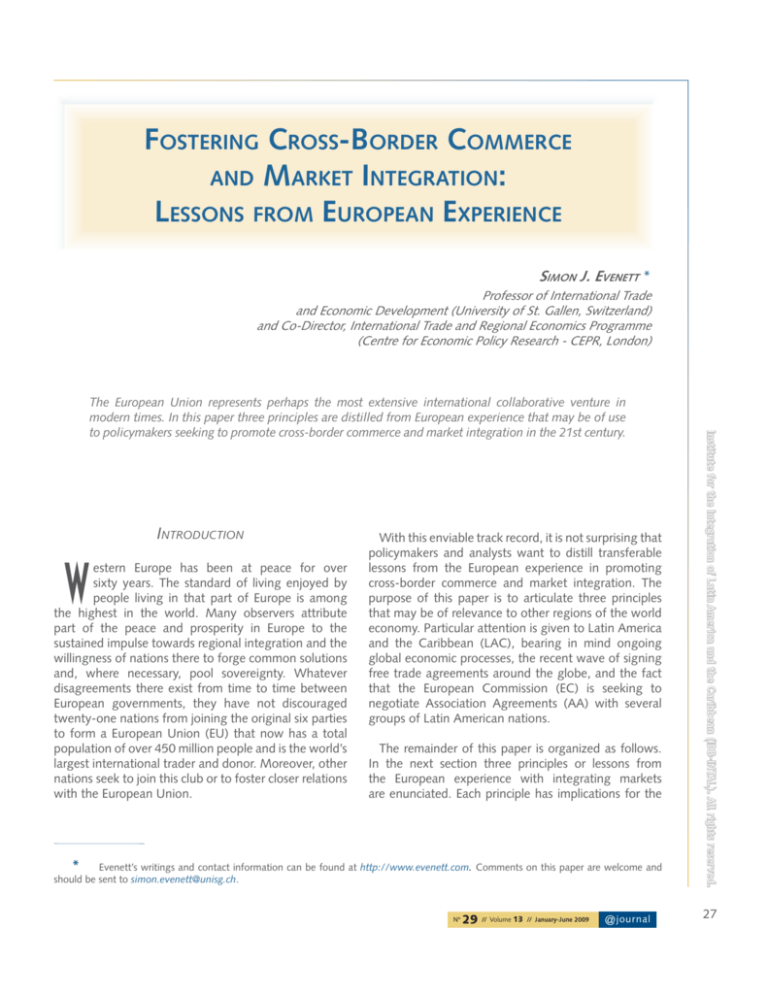
Fostering Cross-Border Commerce
and Market Integration:
Lessons from European Experience
Simon J. Evenett *
Professor of International Trade
and Economic Development (University of St. Gallen, Switzerland)
and Co-Director, International Trade and Regional Economics Programme
(Centre for Economic Policy Research - CEPR, London)
Introduction
W
estern Europe has been at peace for over
sixty years. The standard of living enjoyed by
people living in that part of Europe is among
the highest in the world. Many observers attribute
part of the peace and prosperity in Europe to the
sustained impulse towards regional integration and the
willingness of nations there to forge common solutions
and, where necessary, pool sovereignty. Whatever
disagreements there exist from time to time between
European governments, they have not discouraged
twenty-one nations from joining the original six parties
to form a European Union (EU) that now has a total
population of over 450 million people and is the world’s
largest international trader and donor. Moreover, other
nations seek to join this club or to foster closer relations
with the European Union.
With this enviable track record, it is not surprising that
policymakers and analysts want to distill transferable
lessons from the European experience in promoting
cross-border commerce and market integration. The
purpose of this paper is to articulate three principles
that may be of relevance to other regions of the world
economy. Particular attention is given to Latin America
and the Caribbean (LAC), bearing in mind ongoing
global economic processes, the recent wave of signing
free trade agreements around the globe, and the fact
that the European Commission (EC) is seeking to
negotiate Association Agreements (AA) with several
groups of Latin American nations.
The remainder of this paper is organized as follows.
In the next section three principles or lessons from
the European experience with integrating markets
are enunciated. Each principle has implications for the
* Evenett’s writings and contact information can be found at http://www.evenett.com. Comments on this paper are welcome and
should be sent to simon.evenett@unisg.ch.
Nº
29
// Volume 13 // January-June 2009
@ journal
Institute for the Integration of Latin America and the Caribbean (IDB-INTAL). All rights reserved.
The European Union represents perhaps the most extensive international collaborative venture in
modern times. In this paper three principles are distilled from European experience that may be of use
to policymakers seeking to promote cross-border commerce and market integration in the 21st century.
27
Simon J. Evenett
content and conduct of regional integration initiatives,
highlighting often the importance of complementary
institutional and non-commercial factors. The various
aspects of the EC’s current common external commercial
policy are summarized in the third section, and LAC’s
place in that policy is described. In this section some
aspects of the relationship between that policy and global
commercial trends, multilateral trade negotiations, and
the proliferation of regional trade agreements in the
past 15 years is explored. The fourth and final section
looks forward and reflects on the potentially enduring
lessons from European experience.1
Institute for the Integration of Latin America and the Caribbean (IDB-INTAL). All rights reserved.
Three principles to guide regional economic
integration based on EU experience
28
T
he process of integrating Europe’s markets,
of eliminating overt and subtle barriers to the
flow of goods, services, persons, and capital
within the EU, started over 50 years ago and is by
no means complete. Goods markets are relatively
well integrated but much remains to be done to
assure the other three “freedoms” of movement.
Still, functional supranational institutions -in the
form of the EC, European Court of Justice (ECJ),
European Parliament, and associated agencies- have
been created and several attempts made to refine
the allocation of so-called competences between
the Member States and these supranational bodies.
It is important to appreciate that the momentum
behind furthering the four freedoms has embedded
and flowed, and that from time-to-time more of the
impetus behind integrating Europe’s markets has
come from the EC and the ECJ than from the Member
States themselves.
At the risk of over-simplification and without any
claims of particular originality, the following three
principles characterizing the European approach to
integrating markets can be discerned:
1
With the constraints on this paper’s length it is impossible
to do justice to the multi-faceted literature in economics, political
science, international relations, and history on European economic
integration. Moreover, the focus here will be principally, but not
exclusively, on commercial relations and regional market integration,
ignoring the many other policy domains where the EU has become
such an important force, such as climate change.
Eliminating border barriers to trade is not enough
E
uropean experience bears out that abolishing
intra-regional tariffs, quotas, and other forms
of blatant discrimination against foreign goods
at the customs house is a necessary but not sufficient
condition for the regional integration of markets.
Time and again European governments have resorted
to discriminatory state measures not related to the
customs house to keep out imports and to frustrate
previous trade reforms. Product and health and safety
standards, policies towards state aids and financial
support for firms, and the enforcement of competition
law have all been applied by European governments in
a discriminatory fashion to keep out imports.
The pressures on political leaders to protect jobs and
to shelter locally-based firms is not unique to Europe,
however. This first principle implies that serious attempts
to integrate markets need to address a wide range of
government policies and it should not be surprising
that this realization has led to free trade agreements
(FTAs) covering a wide range of state policies that,
whether intended or not, can have discriminatory
effects. Moreover, as subtle trade barriers replace a
previously banned discriminatory instrument it should
not be surprising that there has had to be a sequence
of initiatives to integrate European markets, leading
neatly to the second principle.
View cross-border integration initiatives as incomplete
contracts, so put the institutional machinery in place
to cope
E
uropean experience suggests it is best to think of
initiatives to integrate markets, including regional
trade agreements,2 as incomplete contracts. In
fact one might go so far as to argue that in practice
it is impossible at any one point in time to foresee all
of the possible ways in which cross-border movement
of goods (let alone services, investments, and people)
can be frustrated by government measures or decisions
2
Throughout this paper regional trade agreements,
free trade agreements, and bilateral trade agreements are used
synonymously. Of course, the former is the term employed in
discussions of these matters at many international organisations,
even in the somewhat confusing case when the parties to any such
agreement are not located in the same continent.
Fostering Cross-Border Commerce and Market Integration
by governments not to take certain measures.3 This
realization has lead to the appreciation that no set of
regional agreements in Europe is regarded as the last
word. Future revisions are not only likely, but expected.
Regional integration in Europe, then, has been an
evolving process, for sure with fits and starts, and not
a one-off event.
Commercial
gain, even mercantilism, need not solely
determine the momentum for cross-border integration
and co-operation
S
o much of the language of many trade negotiations
centers on “concessions,” “reciprocity,” and
the like. While commercial considerations, both
Member States jockeying with one another within
3
Such as declining to apply a national competition law to
investigate allegations that domestic firms have blocked distribution
channels to foreign rivals.
4
In the European case the need for such institutional
arrangements was heightened by the fact that the Member States
decided to form a customs union and so needed a mechanism to
determine what their external commercial policy would be, including
the negotiating mandates for any negotiation with trade partners,
and who would negotiate on their behalf of the Member States.
Over time the set of government policies that have become the “sole
competence” of the European Commission and upon which the EC
negotiates alone with a foreign trading partner has expanded.
5
In some accounts of European integration experience,
some have argued that when the momentum behind integration
slowed (as was the case in the 1970s) some of the decisions taken
by the ECJ opened the door for future regional initiatives and
integration of markets.
Concerns about the distributional and social
consequences of regional integration have played
a greater role in recent years in Europe. An initiative
to liberalize service sector markets was effectively
blocked in the European Parliament by a constituency
concerned about the effects on wages of service sector
employees and on the quality and affordability of public
sector services of possible cross-border competition in
these activities. More generally, the impression has
arisen in some Member States (most notably France)
that EC economic initiatives are principally about
maximizing corporate opportunities and systematically
overlook the wellbeing of others, such as employees.
And, of course the relative importance that a Member
State gives to commercial versus other considerations
may vary over time, evolving perhaps as the parties in
government change.
Learning how to accommodate disparate motives for
cross-border co-operation is essential. In Europe this has
involved “grand bargains” across seemingly-unrelated
policy domains and financial transfers between Member
States. Therefore, analysts should not be surprised if
regional trade agreements grow in scope over time,
often including policies and measures that many may
view as having nothing to do with commercial policy.
In sum, these three principles characterize (in reverse
order) the motives for, the mechanisms to channel
the impetus for, and the scope of the cross-border
co-operation and integration of markets observed in
Europe over the past decades. These principles may
be of interest, even relevance, to governments in
other regions seeking to sustain regional co-operation
and integration over many years. None of the above
discussion is meant to suggest that others must follow
the tenets of the European approach. Indeed, others
may have different combinations of means and ends
Nº
29
// Volume 13 // January-June 2009
@ journal
Institute for the Integration of Latin America and the Caribbean (IDB-INTAL). All rights reserved.
Regarding the cross-border integration of markets
as a sequential process raises practical challenges as to
where realistic proposals for reform are to come from and
on what basis and in what fora a sequence of decisions
among Member States are to be made.4 Entrenching a
body, comprised of experts that collectively have the
power of initiative (that is, to propose new measures),
independent of the Member States’ governments, into
a regional integration schema helps overcome the first
practical challenge, and provides one rationale for the
EC.5 The creation of the European Council of Ministers,
its rotating presidency, and complicated voting rules
sought to address the second challenge. This is not
to say that these two practical challenges must be
addressed à la EU, but it does suggest any sustained
attempt to integrate cross-border markets requires
alternative means to the same ends.
Europe and concerns about European competitiveness
compared to other parts of the world, have played
their part in shaping European cross-border integration
initiatives, it would be misleading not to point out the
key role that historical legacies (three wars between
European nations between 1870 and 1945), geopolitics
(the Cold War), and social considerations have played
in advancing and, in some cases (see next paragraph
for an example), holding back the pace of cross-border
integration of markets in Europe. These factors simply
could not be ignored and in other regions they should
be identified and harnessed if possible, certainly taken
into account, and possibly all three.
29
Simon J. Evenett
that are both feasible and desirable. Nor is there a
suggestion that these three principles cover every factor
that was important at some point in time in European
experience, but then such are the perils of trying to
draw first-order lessons from an integration trajectory
that has lasted more than 50 years.
Current EC External Commercial Policy
T
Institute for the Integration of Latin America and the Caribbean (IDB-INTAL). All rights reserved.
he current common external commercial policy
of the European Union is described in the EC’s
Communication titled Global Europe, issued in
October 2006 and approved soon after by the Member
States. The EC reiterated its continued support for
this policy in 2008 arguing that the strategy was an
“important step forward in European trade policy”
(EC [2008], p. 5). By adopting Global Europe, the EC
characterized both the principal change involved and
motivation for its commercial policy as follows:
30
“Its main focus was on the wider picture
beyond current World Trade Organization
(WTO) negotiations, with trade policy being seen
as part of the wider globalisation agenda. The
aim was to make sure that the most important
challenges and pressures of the global age were
addressed, and that EU trade instruments were
fit for that purpose. This Communication set
out an agenda for opening the most important
markets, and for keeping the EU’s markets open,
competitive and protected from unfair trade.
It represented an agenda based on positive
reciprocity-reciprocal opening, not closing, of
markets” (EC [2008], p. 5).
Several comments about this statement are in
order, especially in the light of the scope of this
paper.6 The first observation is that the EC has
sought to align its external commercial policy with
the objectives and initiatives undertaken in respect
to the internal integration of European markets, that
was the subject of the last section. The Renewed
6
One initiative hinted at in the quoted text and that was
aborted by the EC was the reform of its anti-dumping, countervailing
duty, and safeguards provisions (the “trade defense instruments” in
EC parlance). These reforms were abandoned in the face of strong
Member State opposition and are not discussed here.
Lisbon Strategy, adopted in 2005, that places great
store on revitalizing the productivity and employment
growth as well as the commercial viability of the
EU economy, provides the overarching objectives
of internal and external EC commercial policies.
Interestingly, the EC has often argued that support
for its open markets at home is dependent on being
able to open markets abroad and demonstrate that
foreign trading partners are providing European firms
with a chance to compete for business. Moreover,
the EC has argued that European firms are more likely
to compete effectively on world markets if they face
tough competition at home. Now, stating objectives
and identifying policy complementarities (such as
these) is one thing, capitalizing on the latter to meet
the former is another. Still governments, in particular
developing country governments, are often advised
to align their strategy towards openness with their
broader development strategies and arguably Global
Europe represents a coherent attempt to do just that.
Second, in articulating its three internal policy
priorities the EC argued that globalization has
accelerated structural change in the European
economy and that “we must recognise the potentially
disruptive impacts of market opening for some
regions and workers, particularly the less qualified”
(EC [2006], p. 5). The EC noted that failure to address
such matters jeopardizes social justice, intra-EU
cohesion, and ultimately support for openness and
global economic engagement. That the structural
change was associated with the rise of East Asia is
the first of several indications that the EC’s external
commercial policy has been shaped by recent global
trends and developments abroad.
Third, the Global Europe strategy effectively
terminated the moratorium that the EC and the
Member States had adopted in the late 1990s on
launching new negotiations towards FTAs, or AAs
as EC FTAs signed in the 1990s were often called.
This moratorium took on particular significance once
the Doha Round was launched in November 2001
because the EC encouraged European exporters to
channel all their demands for overseas market opening
into support for ongoing multilateral trade talks. This
turned out to be a risky strategy for as those talks
dragged on, and the perception gained ground that
the ultimate Doha Round outcome would involve
little additional commercial opportunities in the large
emerging markets for European manufacturers and
Fostering Cross-Border Commerce and Market Integration
service sector firms, dissatisfaction grew in certain
powerful Member States with the self-imposed
moratorium.7
Moreover, the aggressive pursuit by the United States
government of a policy of Competitive Liberalization,
that included as an objective the opening of markets
for American firms through signing FTAs with as
many trading partners that were prepared to accept a
demanding “gold standard” agreement, also fed the
impression that European business was falling behind.8
The moratorium’s demise, therefore, was influenced
heavily by developments in multilateral trade fora and
a leading rival’s FTA strategy.
In the Global Europe Communication, after affirming
the EU’s commitment to the WTO and to completing
the Doha Round, the EC argued that FTAs:
The policy issues emphasized in the above quotation,
in particular reform of service sector and investment
policies, are precisely those that the EC has argued
repeatedly were critical for maintaining and extending
European commercial success in world markets, in
particular in high value-added manufacturing and
In its preparations for the launch of the Global
Europe strategy the EC took into account the following
economic factors when identifying its next set of FTA
partners: potential market size and growth of the
trading partner, level of protection (including non-tariff
barriers) in place against EU export interests, the FTA
negotiations that a potential partner has concluded or
are under way with other countries, the possible effects
of the FTA on EU markets and employment,10 and the
potential negative impact on the EU’s preferential
market access schemes that tend to benefit developing
countries and countries close to the EU. On the basis
of these criteria the EC identified the South East Asian
Nations (ASEAN), Korea, and MERCOSUR as priority
countries for completing FTAs with (although in the
case of MERCOSUR this would entail concluding an
existing FTA negotiation that was started before the
moratorium came into effect.) Potential FTAs with
India, Russia, and the six Gulf Co-operation Council
countries were mentioned by the EC. Interestingly
China, although meeting several of the above criteria,
was singled out for differential treatment, it being felt
that an FTA would not find favor with some EU Member
States. In addition to these negotiating plans, the EC
was committed to concluding Economic Partnership
Agreements (EPA) with the African, Caribbean, and
Pacific countries (ACP).
7
German manufacturing firms, it was said, were particularly
unhappy with the moratorium.
8
The fact that the USA share of world exports fell more than
twice as fast as that for the 25 original members of the EU during the
years 1995-2005 belied the fear of European exporters. There again,
fears don’t have to be true to be effective arguments in policy arenas.
Perhaps the greater irony is that the incoming Bush Administration
in 2001 used the EU’s signing of FTAs in the 1990s, that is before
the self-imposed moratorium, as its justification for launching new
negotiations towards free trade agreements. By the end of the Bush
Administration in 2008 it was difficult to find independent analysts
prepared to argue that the strategy of Competitive Liberalization
had delivered the gains to USA business that the Administration had
originally claimed.
9
See, for example, the statements made on page 6 of EC
[2006] and throughout EC [2008].
10
This includes sectors that are particularly sensitive in the
EU such as agriculture. Indeed, so sensitive is the latter sector that
European proponents of the new FTA negotiations were, it was
reported in the specialist press, forced by certain Member States
to accept that agricultural trade and support policies would not be
on the negotiating table. Given that many developing countries,
including those in Latin America, have a comparative advantage in
the agricultural production this limits the benefits of an FTA with the
EU to such trading partners.
Nº
29
// Volume 13 // January-June 2009
@ journal
Institute for the Integration of Latin America and the Caribbean (IDB-INTAL). All rights reserved.
“if approached with care, can build on WTO
and other international rules by going further and
faster in promoting openness and integration, by
tackling issues which are not ready for multilateral
discussion, and by preparing the ground for the
next level of multilateral liberalisation. Many key
issues, including investment, public procurement,
competition, other regulatory issues and
intellectual property rights (IPR) enforcement,
which remain outside the WTO at this time can
be addressed through FTAs” (EC [2006], p. 10).
services.9 The EC also noted that it had a high level
of commercial ambition for its FTAs and that “broader
political considerations” would influence the decision
to launch FTA negotiations with a trading partner and
that any FTA provisions would be part of a “wider
institutional architecture (EC [2006], p. 12)” between
the EC and the trading partner concerned, implying
that the ultimate agreement would likely include
provisions on non-commercial policy matters, such as
scientific co-operation and exchanges, just like the AAs
signed in the 1990s.
31
Simon J. Evenett
Institute for the Integration of Latin America and the Caribbean (IDB-INTAL). All rights reserved.
What has the EC achieved with its new FTA strategy?
Perhaps it is too soon to come to any definitive
judgment, however, at best the picture is mixed. No
FTA negotiation has been concluded, although the
negotiations with Korea are said to have considerably
advanced. Having said that, the sticking points in the
latter negotiation (treatment of automobile imports
and rules of origin) have remained unresolved for over
half a year and official estimates of the conclusion of
these negotiations keep being moved back. Moreover,
there are indications from informed parties that the
negotiated text (still secret) goes little beyond the FTA
text agreed between Korea and the United States. Still,
the Korean economy is a sizeable one and trade with
the EU exceeded €53 billion in 2005.
32
As far as Latin America and the Caribbean are
concerned, the FTA negotiations with MERCOSUR have
been put on hold until after the conclusion of the Doha
Round (putting to one side a very difficult negotiation
over agricultural trade and support policies). Broader
partnership negotiations with the Andean Community
(CAN) were launched by the EC, but divisions among the
former’s governments over the desirability of an FTA with
the EU have stalled negotiations. EC negotiations with the
Central American countries, motivated in part by the USA
conclusion of its FTA negotiations with these countries,
are said to be well advanced. The EC’s EPA negotiations
with the Caribbean countries were concluded but the
agreement has not come into effect because of second
thoughts on the part of certain developing countries. In
sum, no Latin American or Caribbean country has gained
improved preferential market access to EU markets since
Chile concluded its AA in 2002.11
This section has described the shift in the EC’s
external commercial policy from an almost exclusive
focus on negotiating the Doha Round and the EPAs,
with their emphasis on developing global rules and
governance and by promoting development, to a
more competitiveness-driven agenda that involved
the launching of a new wave of FTA negotiations. In
many respects this evolution in EC external commercial
policy was shaped by the implications of ongoing global
economic integration, differential negotiating success in
various trade policy fora, and a renewed priority given by
the current EC to promoting European competitiveness
with all available means. With respect to the latter, the
alignment of current EC external commercial policy
with its internal economic priorities is noteworthy and
may well be of interest to governments in other regions.
11
FTA negotiations are, of course, not the only vehicle
through which the EU and LAC engage in dialogue and potential
collaboration. The European Union-Latin America and Caribbean
Partnership was launched in 1999 at a summit in Rio de Janeiro,
Brazil, and a similar summit has followed every two years.
Looking forward and concluding remarks
The EC’s approach to integrating its own region’s markets and to
negotiating FTAs with its trading partners is multi-faceted and reflects
a broad set of commercial and non-commercial goals that mirror the
diversity of values among governments representing 450 million people,
the wide range of European economic interests, and the recognition
that many state measures affect the commercial opportunities of firms.
These underlying causes are not unique to the European continent and
counterparts can be found in the other jurisdictions. Looking forward,
it is difficult to see these underlying causes becoming less important.
Consequently, free trade agreements are likely to grow in scope,
implicating more levels of government and areas of policymaking.
Moreover, these accords are likely to include more provisions to review,
renegotiate, and extend co-operation. Ultimately, then, the European
contribution to integrating markets may well be to have demonstrated
that FTAs need not be one-off deals whose disciplines are confined to
border barriers, but as vehicles for creating and then sustaining through
institutional mechanisms inter-governmental co-operation across a wide
range of state policies of mutual interest to the parties concerned.
Fostering Cross-Border Commerce and Market Integration
Bibliography
European Commission - EC. Global Europe: Competing in the world. A Contribution to the EU’s Growth and Jobs
Strategy. Brussels. October 2006. http://europa.eu/legislation_summaries/external_trade/r11022_en.htm
European Commission - EC. Global Europe: EU performance in the global economy. Brussels. October 2008.
http://trade.ec.europa.eu/doclib/docs/2008/october/tradoc_141196.pdf
Institute for the Integration of Latin America and the Caribbean (IDB-INTAL). All rights reserved.
Nº
29
// Volume 13 // January-June 2009
@ journal
33
Institute for the Integration of Latin America and the Caribbean (IDB-INTAL). All rights reserved.

